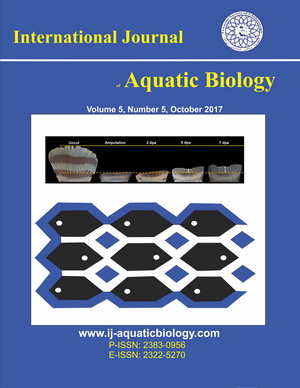Aspects of the growth of Microcystis aeruginosa on dyes and its bioremediation potential in textile effluents
Downloads
Given the textile sector's intense economic activity, its effluents are known to contribute to water quality degradation, with ecological and ecotoxicological implications. This study aimed to evaluate the influence of pure textile dyes (tartrazine yellow and indigo blue) on the growth of the cyanobacterium species Microcystis aeruginosa through direct and indirect methods. Furthermore, it aimed to verify whether this species has bioremediation potential in effluents contaminated with dyes through ecotoxicological evaluation and color reduction. Therefore, we added an inoculum of 3x103 cells/mL of M. aeruginosa to a concentration of 500 mg/L of each pure dye in solutions with WC medium. They remained in direct and indirect light for seven days, and the number of cells was evaluated over 168 hours. Then, we collected two types of effluents representative of the dyes studied (jeans factory blue dye and carpet factory yellow dye), which remained raw and diluted by 50%. We added an inoculum of 8.64x103 ± 93 cells/mL of this cyanobacterium to each effluent. Moreover, we added a control without inoculum for each condition. Aeration remained constant for 25 days. We conducted ecotoxicological evaluations of the effluents (before and after 25 days of bioremediation) through seven-day assays with the larvae of Danio rerio, verifying survival and growth parameters. The results showed that the cyanobacterium grew significantly in direct contact with the tartrazine yellow dye (1.49x105 ± 1910 cells/mL). However, growth was reduced with both dyes in indirect contact, and there was total inhibition with indigo blue in direct contact, significantly differing from the control. After 25 days, the number of cells in the effluents diluted by 50% decreased compared to the inoculated amount. Considering the color reduction in the carpet factory effluent (100%), the presence of cells enabled a 43% reduction, and in the only aerated condition, 34.6% decolorization. Thus, considering the greater color degradation in the presence of cyanobacteria in this effluent, we believe that cell growth and active metabolism occurred before the 25 days tested. The color removal percentages in the presence of cells did not reduce toxicity. Therefore, we concluded that M. aeruginosa has the potential to grow in high concentrations of tartrazine yellow (500 mg/L).
Downloads
Abe F.R., Mendonça J.N., Moraes L.A.B., Gravato C., Soares A.M.V.M., Oliveira D.P. (2017). Toxicological and behavioral responses as a tool to assess the effects of natural and synthetic dyes on zebrafish early life. Chemosphere, 178: 282-290.
ABNT 15499 (Associação Brasileira de Normas Técnicas). (2016). Ecotoxicologia aquática: Toxicidade Aguda– Método de ensaio com peixes. Rio de Janeiro.
ABNT NBR 12648 (Associação Brasileira de Normas Técnicas). (2011). Ecotoxicologia aquática - Toxicidade crônica - Método de ensaio com algas (Chlorophyceae). Rio de Janeiro.
Amaral F.M., Kato M.T., Florêncio L., Gavazza S. (2014). Color, organic matter and sulfate removal from textile effluents by anaerobic and aerobic processes. Bioresource Technology, 163: 36-369.
APHA (American Public Health Association). (2012). Standard methods for the examination of water and wastewater. 22th ed., APHA, Washington. 1360 p.
Asthana R.K., Chatterjee S., Singh S.P. (1995). Investigations on nickel biosorption and its remobilization. Process Biochemistry, 30(8): 8-734.
Bertoletti E. (2009). Determination of chronic ecotoxicity to Danio rerio. Journal of the Brazilian Society of Ecotoxicology, 4(1-3): 1-3-7.
Burger H., Dickson S., Awad J., Marzouk J., van Leeuwen J. (2021). Investigation of cyanobacteria blooms in paper mill wastewaters and assessment of zinc as a control agent. International Journal of Environmental Science and Technology, 19: 1105-1120.
Carvalho M.M., Lira V.S, Watanabe C.H., Fracácio R. (2017). Estudo da toxicidade de metais (zinco e cádmio) sobre Ceriodaphnia dubia, por multivias de exposição e recuperação biológica de descendentes. Engenharia Sanitaria e Ambiental, 22(5): 961-968.
Cohen Y. (2002). Bioremediation of oil by marine microbial mats. International Microbiology, 5(4): 4-93.
Dellamatrice P.M., Silva-Stenico M.E., Moraes L.A.B., Fiore M.F., Monteiro R.T.R. (2017). Degradation of textile dyes by cyanobacteria, Brazilian Journal of Microbiology, 48(1): 1-31.
De Schamphelaere K.A., Forrez I., Dierckens K., Sorgeloos P., Janssen C.R. 2007. Chronic toxicity of dietary copper to Daphnia magna. Aquatic Toxicology, 81(4): 409-18.
Dubey S.K., Dubey J., Mehra S., Tiwari P., Bishwas A.J. (2011). Potential use of cyanobacterial species in bioremediation of industrial effluents. African Journal of Biotechnology, 10(7): 1125-1132.
El-Bestawy E.A., El-Salam A.Z.A., Mansy A.E.R.H. (2007). Potential use of environmental cyanobacterial species in bioremediation of lindane-contaminated effluents International Biodeterioration and Biodegradation, 59(3): 3-192.
EPA US (United States Environmental Protection Agency). (1992). METHOD 3010A: Acid Digestion of Aqueous Samples and Extracts for Total Metals for Analysis by Flame Atomic Absorption Spectroscopy (FLAA) or Inductively Coupled Plasma Spectroscopy (ICP), 1st edn. United States Environmental Protection Agency, Washington, DC.
Ferrão-Filho A.S., Kozlowsky-Suzuki B. (2011). Cyanotoxins: Bioaccumulation and Effects on Aquatic Animals. Marine Drugs, 9(12): 12-2772.
Forlani G., Pavan M., Gramek M., Kafarski P., Lipok J. (2008). Biochemical basis for a wide spread tolerance of cyanobacteria to the phosphonate herbicide glyphosate. Plant and Cell Physiology, 49: 443-456.
Guillard R.R.L., Lorenzen C.J. (1972). Yellow?green algae with chlorophyllide C12. Journal of Phycology, 8(1): 1-14.
Harke M.J., Steffen M.M., Gobler C.J., Otten T.G., Wilhelm S.W., Wood S.A., Paerl H.W. (2016). A review of the global ecology, genomics, and biogeography of the toxic cyanobacterium, Microcystis spp. Harmful Algae, 54: 4-20.
Henciya S., Shankar M., Maliga P. (2013). Decolorization of textile dye effluent by marine cyanobacterium Linghya sp. BDU 9001 with coir pith. International Journal of Environmental Sciences, 3: 1909-1918.
Holkar C.R., Jadhav A.J., Pinjari D.V., Mahamuni N.M., Pandit A.B. (2016). A critical review on textile wastewater treatments: possible approaches. Journal of Environmental Management, 182: 351-366.
Idi A., Md Nor M.H., Abdul Wahab M.F., Ibrahim Z. (2015). Photosynthetic bacteria: an eco-friendly and cheap tool for bioremediation. Reviews in Environmental Science and Biotechnology, 14: 271.
Imtiazuddin S.M., Mumtaz M., Mallick K.A. (2012). Pollutants of wastewater characteristics in textile industries. Journal of Basic and Applied Sciences, 8: 554-556.
Jinqi L., Houtian L. (1992). Degradation of azo dyes by algae. Environmental Pollution, 75: 273-278.
Joshi V.J., Santani D.D. (2012). Physicochemical Characterization and Heavy Metal Concentration in Effluent of Textile Industry. Universal Journal of Environmental Research and Technology, 2(2).
Kalavathi D.F., Uma L., Subramanian G. (2001). Degradation and metabolization of the pigment melanoidin in distillery effluent by the marine cyanobacterium Oscillatoria boryana BDU 92181. Enzyme and Microbial Technology, 29: 246-251.
Katheresan V., Kansedo J., Lau S., Y. (2018). Efficiency of various recent wastewater dye removal methods: A review. Journal of Environmental Chemical Engineering, 6(4): 4-4697.
Khattar J.I.S., Sarma T.A., Singh D.P. (1999). Removal of chromium ions by agar immobilized cells of the cyanobacterium Anacystis nidulans in a continuous flow bioreactor. Enzyme and Microbial Technology, 25: 564-568.
Koul S., Fulekar M.H. (2013). Petrochemical Industrial Waste: Bioremediation Techniques: An Overview. International Journal of Advancements in Research e Technology, 2(2).
Kunz A., Zamora P.P., de Moraes S.G., Durán N. (2002). Novas tendências no tratamento de efluentes têxteis. Química Nova, 25(1): 1-82.
Lopes Fujita R.M., Jorente M.J.A. (2015). Indústria Têxtil no Brasil: uma perspectiva histórica e cultural. Moda Palavra e-periódico, 15: 153-174.
Mahmood T., Paice M. (2006). Aerated stabilization basin design and operating practices in the Canadian pulp and paper industry. Journal of Environmental Engineering and Science, 5(5): 5-395.
Manekar P., Patkar G., Aswale P., Mahure M., Nandy T. (2014). Detoxifying of high strength textile effluent through chemical and bio-oxidation processes. Bioresource Technology, 157: 44-51.
Manu B., Chauhari S. (2003). Decolorization of indigo and azo dyes in semi continuous reactors with long hydraulic retention time. Process Biochemistry, 38: 1213-1221.
Matsunaga T., Takeyama, H.; Nakao, T.; Yamazawa, A., (1999). Screening of marine microalgae for bioremediation of cadmium-polluted seawater. Journal of Biotechnology, 70: 33-38.
Meireles G., Daam M., Sanches A.L.M., Zanoni M.V.B., Soares A.M.V.M., Gravato C., Oliveira D.P. (2018). Red disperse dyes (DR 60, DR 73 and DR 78) at environmentally realistic concentrations impact biochemical profile of early life stages of zebrafish (Danio rerio). Chemico-Biological Interactions, 292: 94-100.
Mohamed Z.A. (2001). Removal of cadmium and manganese by a non-toxic strain of the freshwater cyanobacterium Gloeothece magna. Water Research, 35(18): 18-4409.
Moreira C., Ramos V., Azevedo J., Vasconcelos V. (2014). Methods to detect cyanobacteria and their toxins in the environment. Applied Microbiology and Biotechnology, 98: 8073-8082.
Mowe M.A.D., Mitrovic S.M., Lim R.P., Furey A., Yeo D.C.J. (2015). Tropical cyanobacterial blooms: a review of prevalence, problem taxa, toxins and influencing environmental factors. Journal of Limnology, 74(2): 2- 24.
Nanda S., Sarangi P.K., Abraham J. (2010). Cyanobacterial remediation of industrial effluents I. Tannery effluents. New York Science Journal, 3(12): 12-36.
Norberg-King T. (1993). A linear interpolation method for sublethal toxicity: the inhibition concentration (ICp) approach (Version 2.0). US Environmental Protection Agency, Environ. Res. Lab.-Duluth, Duluth, MN, Technical Report 03-93 of National Effluent Toxicity Assessment Center.
Ogugbue C., Sawidis T., Oranusi N. (2011). Evaluation of color removal in synthetic saline wastewater containing azo dyes using an immobilized halotolerant cell system. Ecological Engineering, 37: 2056-2060.
Paerl H.W., Otten T.G. (2013). Harmful cyanobacterial blooms: Causes, consequences and controls. Microbial Ecology, 65: 995-1010.
Paerl H.W., Xu H., Hall N.S., Zhu G., Qin B. (2014). Controlling Cyanobacterial Blooms in Hypertrophic Lake Taihu, China: Will Nitrogen Reductions Cause Replacement of Non-N2 Fixing by N2 Fixing Taxa? PLoS ONE, 9(9).
Pagga U., Taeger K. (1994). Development of a method for adsorption of dyestuffs on activated sludge. Water Research, 28(5): 5-1057.
Parikh A., Madamwar D. (2005). Textile dye decolorization using cyanobacteria. Biotechnology Letter, 27: 323-336.
Polyak Y., Zaytseva T., Medvedeva N. (2013). Response of toxic cyanobacterium Microcystis aeruginosa to environmental pollution. Water, Air, and Soil Pollution, 224: 1494.
Raghukumar C., Vipparty V., David J.J., Chandramohan D. (2001). Degradation of crude oil by marine cyanobacteria. Applied Microbiology and Biotechnology, 57: 433-436.
Shah V., Garg N., Madamwar D. (2001). An integrated process of textile dye removal and hydrogen evolution using cyanobacterium, Phormidium valderianum. World Journal of Microbiology and Biotechnology, 17, 499-504.
Silva M.C., Corrêa A.D., Torres J.A., Amorim M.T.S.P. (2012). Descoloração de corantes industriais e efluentes têxteis simulados por peroxidase de nabo (Brassica campestre). Química Nova, 35(5): 5-894.
Silva J., Fracacio R. (2021). Toxicological and ecotoxicological aspects of tartrazine yellow food dye: a literature review. Brazilian Journal of Environmental Sciences (Online), 56(1): 1-151.
Soares M.C.S., Huszar V.L.M., Miranda M.N., Mello M.M., Roland F., Lürling M. (2013). Cyanobacterial dominance in Brazil: distribution and environmental preferences. Hydrobiologia, 717: 1-12.
Sözen S., Olmez-Hanci T., Hooshmand M. (2020). Fenton oxidation for effective removal of color and organic matter from denim cotton wastewater without biological treatment. Environmental Chemistry Letters, 18: 207-213.
Utermöl H.X. (1958). Zur Vervollkommnung der quantitativen Phytoplankton-Methodik. Mitteilungen. Internationale Vereiningung fuer Theoretische und Angewandte Limnologie, 9: 1-38.
Ventura-Camargo B., Marin-Morales M. (2013). Azo dyes: Characterization and toxicity – A review. Textiles and Light Industrial Science and Technology, 2(2).
Vijayakumar S., Manoharan C (2012). Treatment of dye industry effluent using free and immobilized cyanobacteria. Journal of Bioremediation and Biodegradation, 3: 1-6.
Vijayakumar S., Thajuddin N., Manoharan C. (2005). Role of cyanobacteria in the treatment of dye industry effluent. Pollution Research, 24: 69-74.
West I.N.C., Gulley D. (1995). TOXSTAT 3.5. Wyoming: University of Wyoming.
Yaseen D.A., Scholz M. (2019). Textile dye wastewater characteristics and constituents of synthetic effluents: a critical review. International Journal of Environmental Science and Technology, 16: 1193-1226.
Zastepa A., Pick F.R., Blais J.M., Saleem A. (2015). Analysis of intracellular and extracellular microcystin variants in sediments and pore waters by accelerated solvent extraction and high performance liquid chromatography-tandem mass spectrometry. Analytica Chimica Acta, 872: 26-34.
Zurawell R.W., Chen H., Burke J.M., Prepas E.E. (2005). Hepatotoxic cyanobacteria: a review of the biological importance of microcystins in freshwater environments. Journal of Toxicology and Environmental Health, Part B, 8(1): 1-37.
Copyright (c) 2024 International Journal of Aquatic Biology

This work is licensed under a Creative Commons Attribution 4.0 International License.








